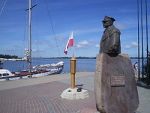Poland's Wedding to the Sea – a patriotic act, first performed on February 10th 1920 at Puck and on March 17th 1945 in Mrzeżyno and on March 18th in Kołobrzeg.

In October 1919 Józef Haller took command of the Pomeranian Front created to recapture Pomerania, lost by the Paritions of Poland, peacefully and according to the plan on the basis of the Vesaille Treaty. According to the plan, taking over the land started on 18 January 1919 with recapturing Toruń by the troops of the 16th Pomeranian Division of Infantry. Particular localities were regained from the withdrawing German army until 11th February 1920 when the last soldiers left Gdańsk.
Despite a few attempts of armed resistance and sabotage, the recapturing of the Pomerania was carried out without dutter. On 10th February 1920 general Józef Haller and Stanisław Wojciechowski, the Secretary of Interior, with the new administration for the Pomeranian province arrived in Puck for the symbolic Poland’s Wedding to the Baltic Sea ceremony to take place.
The main point of the ceremony became the thanksgiving mass, celebrated by Rev. Antoni Rydlewski, with Rev. Józef Wrycz preaching the sermon and the Polish Flag consecrated, then hoisted by the Lieutenant Eugeniusz Popławski and the Mariner Florian Napierała as a sign of the Polish Navy keeping the watch on the Baltic Sea. On behalf of the so far cost guards, the watch was symbolically passed on by the fisherman Jakub Myślisz to the Polish mariner. The Pucka Bay frozen on that particular day, was regarded a good sign by the Kashubians.
In the Wedding ceremonies a ring was cast into the sea. Right before the ceremony the General and the reperentatives of the Polish authorities in Gdańsk met the local Polonia who handed the General in two platinum rings founded by the Polish community of Gdańsk, e.g. the Leszczyński and Raciniewski families.
On 10th February Poland regained 140 km long Baltic sea cost including Hel Peninsula, economically neglected and underdeveloped area. The event deeply inspired Wojciech Kossak to paint Poland’s Wedding to the Baltic Sea.
Poland’s Wedding to the Baltic Sea in 1920: February 10 –Puck - General Józef Haller
Poland’s Wedding to the Baltic Sea in1945:
March 17 – Mrzeżyno – Lancer Corporal Sochaczewski,
March 18 – Kołobrzeg- Corporal Franciszek Niewidziajło.


